Diggin’ In: The Richard Gienger Report
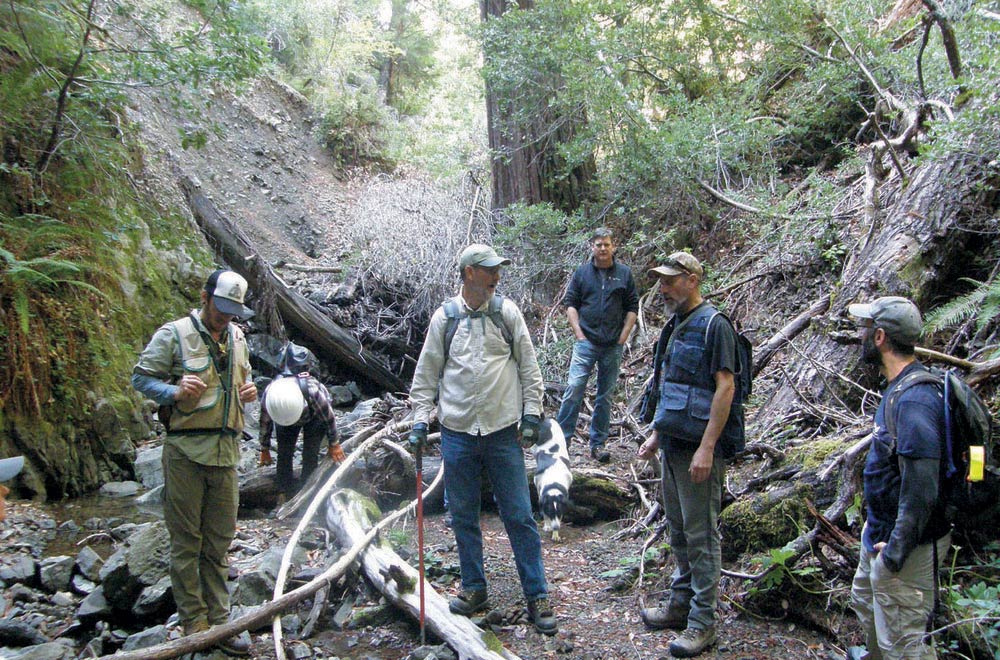
It seems we are in a time of “deep payback” on multiple scales. I have recollections of references during my life to “fire next time” connected to either biblical passages, or perhaps memory of a Malcolm X speech? Refreshing part of my memory, I was reminded that James Baldwin wrote a book with two powerful essays titled The Fire Next Time. Wikipedia states that “The book’s title comes from the couplet ‘God gave Noah the rainbow sign / No more water but fire next time’ in “Mary Don’t You Weep,” a Negro spiritual.”
On the California scale, and in California reality, we are seeing over a hundred and fifty years of bad choices resulting in over-population in the wrong places, depletion of natural resources, and irresponsible social/ economic/environmental relationships that jeopardize our future. One can, and many of us do, extrapolate this problem to earth-scale. I am just going to delve into an assortment of problems that have come to my attention in a mostly regional perspective.
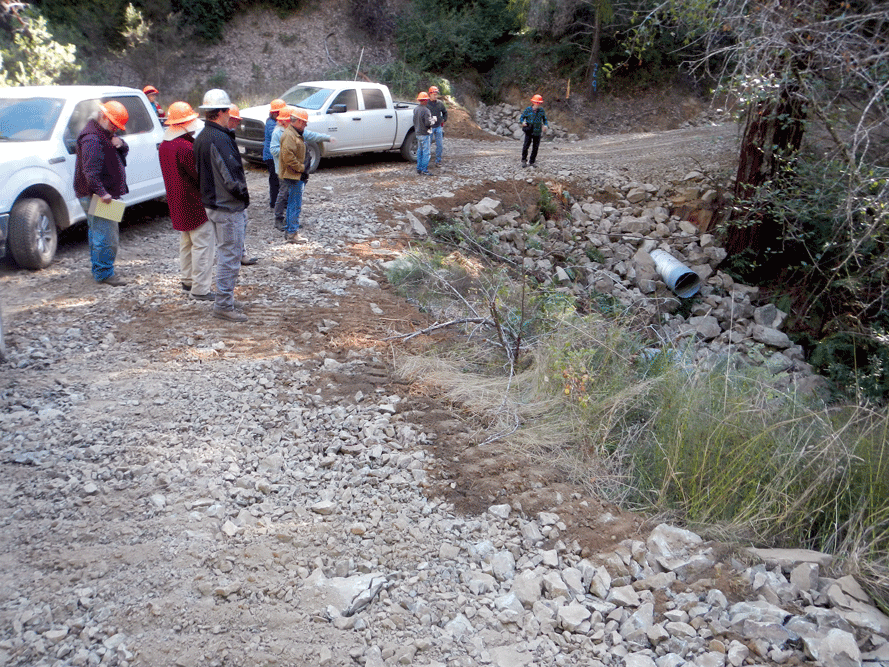
Tour of the Green Diamond Sproul Creek acquisition showing significant road
and drainage upgrades of the road system.
To continue first with the fire theme, I would suggest you run a search for “The Great Fire of 1910” and get a grasp on the causes and impacts of a three million acre fire in the Northern Rockies. The Great Fire of 1910 did most of its damage in two days—and set the stage for human responses for most of the next 100 years. There is also a five-part series that you should experience entitled “California Burning—Preventing Catastrophic Wildfires”—link at https://beta.prx. org/series/38854 You might go to the KMUD archives starting with 9 am Thursday, 24 October for part one, with the other four parts in subsequent weeks in the same time and day slot.
The Kincade Fire started near Geyserville, apparently from a faulty Pacific Gas & Electric transmission line, the evening of October 23rd. On October 30th, the fire was at 76,285 acres (120 square miles) causing the evacuation of 180,000 persons (about the same as were evacuated in 2017 in fear of the failure of the Oroville Dam). Containment on the 30th was at 30% and 246 structures had been destroyed with 80,000 homes at risk. Due to the stellar work of CalFire and an incredible team of partners, the fire was prevented from crossing Highway 101. Their heroics and expertise saved untold lives, homes, and communities.
There were many other concurrent fires all over the state, with millions of homes and businesses cut off from electricity as PG&E flailed around with power outages that compounded the crises. The bankrupt pseudo-public company, in multiple ways, continued to terrorize the “rate-payers” and people of California. One obvious thing that should have been done decades ago was the undergrounding of high hazard transmission lines. The public and the politicians are screaming for reform. Of course the reforms that are needed are multiple and complex—going deep into broad cultural change—not just finding a scapegoat or two. The whole wave of fear and panic can perhaps promote the needed changes. What seems more likely, however, is the persistence of problematic, dominating relationships—with the ostensible “too big to fail” powers calling the shots.
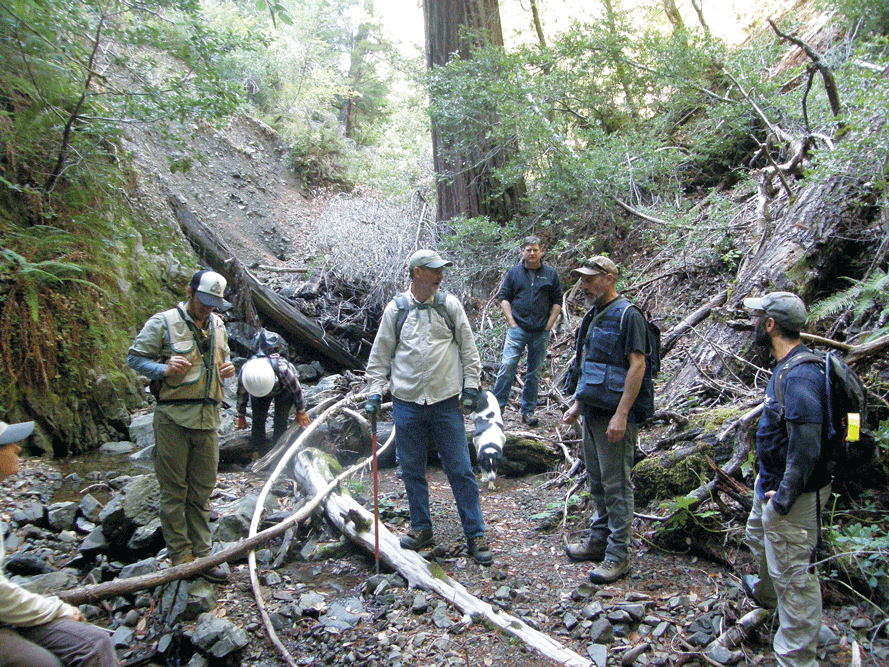
Linwood Gill (URFC Head Forester), Brian McFadden (NCRWQCB), Tom Leroy (Pacific Watershed Associates), and others in the heavily impacted Kline Gulch discussing a potential paired watershed evaluation and treatment project.
all photos this article by Richard Gienger
I am going to hit on some other “out-of-whack” situations, with some hope here and there, now and then, if only we can move the change. One “small” example of “out-of whack” is a small landowner near Carlotta on the Van Duzen River. Last winter, with the thalweg (deepest part of the channel) aimed directly at their home, the middle of a protective bank of rock and large willow, put in place in 1995, was compromised. Efforts were made to take appropriate action based on plans suggested by a number of the top experienced practitioners for such a situation. At least one state official claimed that 4½ to 5 years of analysis were necessary before anything could be approved. And, from what I understand, nothing was approved that was appropriate to the situation. Aside from solving their specific plight, the big picture of the condition and needed corrective measures for the Van Duzen River are not being considered or implemented. Huge, high, and vegetated gravel bars are pushing the river into failing banks, threatening not only homes, but also threatening a three-foot diameter gas line that runs from the Central Valley to the Humboldt Bay Power Plant that still has nuclear waste stored there.
Usal and the Sinkyone Wilderness Coast
Ahh, fools and fireworks on Usal Beach ignited a fire this past summer. This turned out to be a ‘good fire’ and did not spread into forested canyons and destroy recovering forests. It did point out the complete inadequacy of the Usal and related road networks when it comes to enabling emergency access and evacuation of the public.
More “Out-of-Whackness”
The worst of the landslide-impaired Needle Rock/Briceland Road locations made the Mendocino County list proposed for funding by the Federal Emergency Management Agency (FEMA). It was selected for funding, which prompted a short-term fix by the County pending the FEMA one million dollar fix—tacking the outside of the road with pilings onto the inner gorge, like we’ve seen recently on Highways 101 and 1.
The original purchase of the Georgia-Pacific 7,500 acres in 1985 that were added to the Sinkyone Wilderness State Park, Sinkyone State Wilderness, and InterTribal Sinkyone Wilderness cost a bit over $3.4 million. Oh, and the latest is that the County wants a new bridge over Usal Creek that will cost $5 million. All so strange, and despite some good work the County has done on some parts of the Usal Road, the road remains a hazard to the public, to emergency responses, and to important natural and cultural values.
Purchase by Green Diamond of 9,000 acres of the Sproul Creek Watershed:
This is pretty hard to take, with the battle against herbicides in that watershed that resulted in the founding of the Environmental Protection Information Center (EPIC) in the mid 70s. In the subsequent years, Barnum Timber Company, using herbicides, created an ideal locale for Green Diamond to practice a 35-acre clearcut and herbicide silviculture with harvested trees reaching an age of only 45-55 years—hardly a forest, yet ostensibly compliant with certification standards set by the Forest Stewardship Council, attained on other Green Diamond North Coast properties. When asked on a recent Green Diamond tour of the new Sproul Creek holding about what incentives it would take for them to actually grow older, higher quality trees, spokesmen weren’t able to come up with credible examples. To their credit they are embarking on serious road upgrades, and hiring skilled local young contractors for that and for logging operations.
For a Couple of Positive Notes:
Lost Coast Forestlands has purchased the Van Arken Mattole River tributary near Whitethorn Junction. The 400+ acre watershed has been an important project of Sanctuary Forest, and the Chinook, coho, and steelhead habitat and public values are to be emphasized.
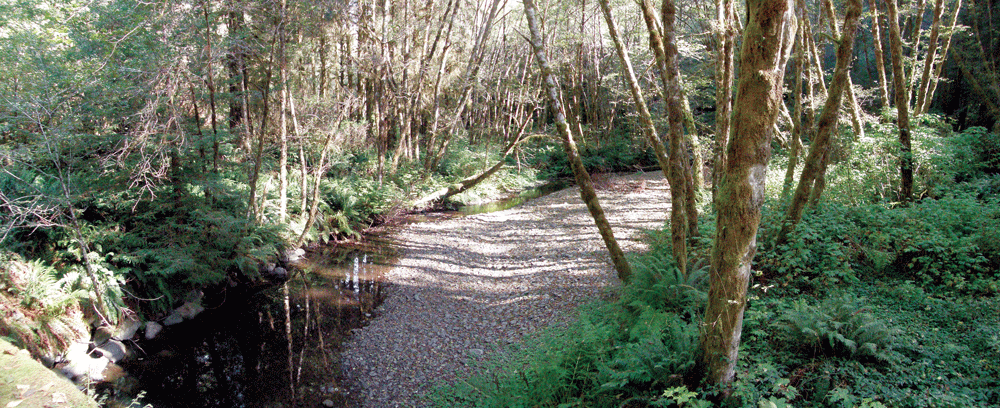
Upstream view of aggraded reach showing land-use impacted Lost Man Creek on ISF Creek Walk.
Redwood Forest Foundation, Inc. (RFFI) continues to pursue forest and watershed recovery in its Usal Redwood Forest—currently and notably Soldier and Moody Creeks. A serious look is being taken at conducting a paired watershed/forest study that emphasizes hydrological recovery in two tributaries of Standley Creek. The second annual “Usal Hopper” mountain bike races happened recently, and the riders were enthusiastic about what RFFI’s goals and practices mean for the forest.
The Institute for Sustainable Forestry is continuing with their workshop tours, the latest being a Creek Walk, led by renowned geologist Mary Ann Madej, to pristine Prairie Creek; impacted Lost Man Creek; and very impacted Redwood Creek. We are all thrilled that Tim Bailey, who has been a large driving force behind those tours, recently was hired to be the Watershed Forest Health Coordinator for Marin, Napa, Mendocino, Lake, and Humboldt Counties, by the Resource Conservation Districts and the North Coast Resource Partnership.
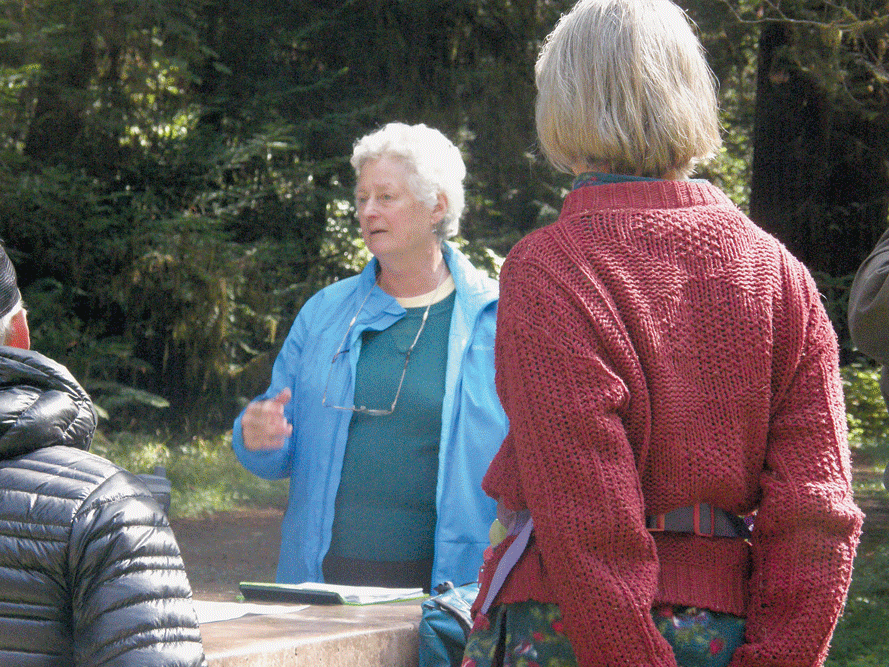
Mary Ann Madej, retired USGS research geologist, and emeritus adjunct HSU professor, teaching on the ISF Creek Walk with Nonae Sears to the right in the foreground.
Getting Back to the
Less Positive:
The forest stewardship possible and necessary for California continues to go unrealized—with the Jackson Demonstration State Forest being a rare example of “how it is supposed to be.” While CalFire and the Forest Management Task Force have increased the scope and scale of thinning and prescribed fire, the necessary standards and incentives for real healthy and high quality forests continue to go unaddressed. Why Forests Matter, led by former CalFire Director Richard Wilson, and Forests Forever continue to try and change that.
Again I’m going to have to postpone going deep into the critical shortcomings of Forest Certification and the failure of Humboldt Redwood Company to follow legal mandates to actually recover forests and watershed from the massive historical “legacy” impacts. The Lost Coast League and Rainbow Ridge are being abused by a company that was once thought to be the salvation of the old Pacific Lumber/Maxxam lands, as well as by a non-transparent mockery of what “certification” is supposed to be about. I’m giving you my response to a piece by John Andersen, the director of forest policy for Humboldt Redwood Co. and Mendocino Redwood Co., called “Come See for Yourself” in the North Coast Journal of August 1st, 2019.
For the North Coast Journal’s
“Guest Views”:
“Come Think for Yourself
I think the spun yarn tapestries that John Andersen presented in defense of the great and good Humboldt Redwood Company have other stories to tell when the intricacies, intrigue, and reality are revealed on the flipside. Don’t get me wrong now; I think John is an earnest and intelligent man doing what he thinks is the right thing, in the right light, for the company. He brings forward all the safety and security concerns, the multitude of compliance hurdles presented by the Forest Practice Act and Rules, the California Environmental Act (CEQA), other legal requirements, and certification of higher standards under the Forest Stewardship Council (FSC)—and
all those tours, just get in touch and ask us.
It is important for people to put all this in a long and short-term context and perspective. The long term of course requires that you read key chapters of Two Peoples, One Place: Humboldt History, Volume 1, by Ray Raphael & Freeman House, Humboldt County Historical Society, 2007. For two aspects of recent history, you should be well acquainted with the incredible development of meaningful, ‘boots on the ground’ commitment to restoration and conservation in the Mattole Valley; and the depredations of PL/Maxxam from the takeover in 1985, through the 1999 Headwaters deal, and the bankruptcy court transfer of PL/Maxxam in 2008 to Mendocino Redwood Company (MRC2). This is so you will not confuse MRC1, the Mattole Restoration Council, the largest employer in the Mattole Valley founded in 1983, with Mendocino Redwood Company. MRC2 purchased the Mendocino and Sonoma County holdings of Louisiana-Pacific (LP) in 1998, holdings there adding up to around 230,000 acres. Now Mendocino has combined with what became Humboldt Redwood Company as HRC/MRC having over 400,000 acres of some of the most productive Redwood land in the world. There are no Redwoods on the 18,000 acres of the rugged heritage Douglas-fir and hardwood forests in the Mattole.
One thing to keep in mind for the end of this Guest View, is that the Mattole PL/Maxxam holdings and Rainbow Ridge were fiercely in contention to be included in the Headwaters deal protections. Citizens like the Lost Coast League’s Michael Evanson brought in propria persona cases against PL/Maxxam’s merciless THPs. A main case of Michael’s was in Sulphur Creek, adjacent to Rainbow Ridge, which still needs protection and recovery, with legacy clearcuts in steep landsliding inner gorges.
When what is now HRC/MRC took over PL/Maxxam there was joy in Mudville. Why, the new manager was Mike Jani, a forester trained and raised in Santa Cruz County, strict all-aged management with larger trees and an engaged public on watch. I have a soft spot for Mike. When he was still with Big Creek lumber at a Board of Forestry committee meeting, must have been the mid-1980s at some cabin in a forest locale as I recall, I was forcefully pressing on the industry folks present that they damn well need to take evaluating and responding to cumulative impacts seriously—the damage from the ad valorem period (1946-1976 a yearly tax on standing timber until you cut 70%) was (and remains) horrific. Those timber folks were, at best, rolling their eyes. Mike Jani piped up, “I think Richard’s right.” Ho, that was seismic for everyone. Having him as the new manager of the former PALCO lands, and even visiting an old-growth tree-sit and getting choked-up telling the sitter it was safe to come down now—had positive resonance, with broad reverberations and hope.
Now, there are lots of details since then that I’m sure of and some less so. One I am sure of is that a fraud suit, led by former CalFire Director Richard Wilson, was brought against Pacific Lumber in 2007 for using tanoak timber volumes illegally to pad their estimates of what sustainable levels of harvest were. It ended going to settlement for a variety of financial and strategic problems. Another certainty was that the Environmental Protection Information Center (EPIC), after 10 incredible years of litigation against the approved Sustained Yield Plan (SYP), prevailed when the California Supreme Court ruled in their favor against PL and CalFire. The court also chastised CalFire for approving a document that did not actually exist. There are certain factors facing HRC-MRC I’m not as sure of, like did the bankruptcy judge tack on another $50 million to the cost to be paid to certain creditors? One way or another the degree of forest depletion and purchase price seems to have created an internal crisis.
Jumping to the last several years: Anybody notice that for the most part the log decks at Scotia and elsewhere are almost entirely 6” to 16” in diameter? Liquidation logging is alive and well, and is the industry’s business plan. Some folks now call the HRC-MRC owners the Gap Bros, and the Bros ushered Mike Jani off to emeritus status and brought in Sierra Pacific Industries (SPI) management, Bob Mertz and Dennis Thibeault to damn well get the cut out. Mike was kindly brought out of retirement to take Mike Miles’ HRC-MRC seat on the Board of Forestry.
Now, doing the Reader’s Digest condensed form: In 2014, there was, in retrospect, a hella good HRC/MRC meeting led by then Manager Mike Jani. Probably were 30-40 folks from the company/public spectrum. At the end of the meeting we were assured that we would start with a day-long scoping session with their Mattole Watershed Assessments as a first
step to putting together a true restoration-recovery plan for the 18,000 acres in the Mattole. Never happened. Jani’s gone and the SPI management doesn’t have “public” in their normal vocabulary.
Now, shorter than short: The whole FSC current song and dance needsa Guest View all its own. The initial formative vision came out from supporters of sustainable working forests for the people of the North Coast. One of the principles of certification is harmony with the mores of surrounding communities. We are not talking total protection or total eradication—we’re talking generational recovery partnership into the future with Mattole Restoration communities, the Bear River Band, the UC Natural Reserve System, and yes, working forest interests (with the fresh 2008 perspective in mind). Bless the activists—think for yourself and work together.”

Lower Redwood Creek above Orick showing extreme aggradation from heavy past logging and severe flood events.
That’s it Folks,
Food for Thought
Please help out where and when you can. Check out the workshop tour programs and other information for Sanctuary Forest, the Institute for Sustainable Forestry (ISF), and EPIC.—rg
